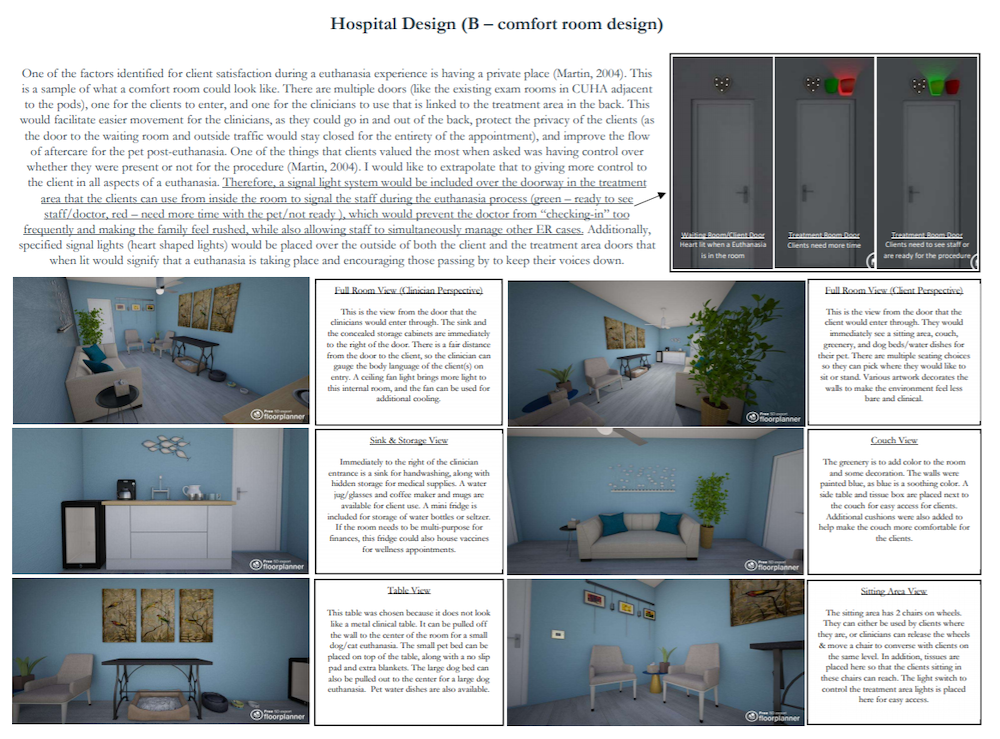Cornell Vet euthanasia course wins grand prize in international contest
Euthanizing a beloved pet can be crushing for a family. It also presents challenges for veterinarians, particularly when it comes to effectively communicating with a grieving pet owner. Through the course Small Animal Euthanasia: Clinical Communication and Practice, instructor Ariana Boltax, D.V.M. ’18, is working to ensure her students gain these crucial communication skills — despite the shift to virtual learning that made in-person instruction impossible last spring.
Now, Boltax’s unique course design has earned the grand prize in the COVID Educational Creations Contest, an international competition run by VetMedAcademy, which is a non-profit that creates and curates open-source educational resources. Her materials were made available to veterinary professionals July 17.
“Winning first place is an honor. It was important to me to find a way of sharing this course with other veterinary educators,” said Boltax. “Our students have the science down when it comes to euthanasia; they know the chemistry and the drugs — the medicine side — really well, but one gap in their instruction overall is ensuring that they’re able to effectively communicate about it with clients.”
Boltax’s course teaches communication skills using euthanasia as the context. This class is typically offered to fourth-year veterinary students at the Cornell University College of Veterinary Medicine (CVM), but this spring, it was opened up to third-years because of the pandemic.
“Welcoming the third-years was actually a really unique and valuable experience,” said Boltax. “It juxtaposed students who had yet to go through their clinical rotations and those who had, so the perspectives were diverse.”
Typically, she noted, most communication skills surrounding the euthanasia experience are learned through observation at the Cornell University Hospital for Animals while students are on clinical rotations. By supplementing observation with this elective class, students act out scenarios with each other and with actors posing as clients, and perform the euthanasia process with Robo Jerry, a robotic canine model.
With the COVID-19 crisis preventing any in-person scenarios, Boltax combined virtual instruction methods and custom course design to shepherd her students through the skill. “One important factor in instructing and assessing their proficiency is the fact that competencies like communication are case-specific,” she said. For example, a veterinarian could excel at communicating with clients who are crying but may struggle with clients who are angry. “That doesn’t mean you're average at communication — it means that you're really good at one context and you need to improve on the other,” Boltax said. Therefore, presenting students with a variety of clinical situations and opportunities to practice in different ways is key.
Instead of in-person scenarios, the simulations were done via Zoom. “The pandemic has increased the popularity of telemedicine and I’m confident that this mode is here to stay,” said Boltax. “So this was a unique opportunity for students to see the virtual interactions in their future as well.”
Boltax scaffolded the course so that students weren’t simply thrown into the simulations without support. “The actual communication with clients, that’s just one step in a larger process,” said Boltax, who provides students with suggested phrasing, assessment prompts and background information. Students also complete cultural competency training to learn how different clients might interpret each situation depending on their various backgrounds, beliefs, ethics and more. “That component is key,” Boltax said. “I want them not to be single-minded when they’re in a real-life scenario with a client, or react with a lack of understanding.”
In addition to running scenarios via Zoom, students practice written communications by writing sympathy cards to clients who have lost a pet. They discuss how to interpret virtual non-verbals and how to console someone virtually, for example, when they can’t offer tissues.
“We talk a lot about modeling vulnerability,” added Boltax.
Channeling creativity and sharing results
Above, a song about compassion fatigue related euthanasia. It was written, performed and analyzed by veterinary students Sierra Bouchard, D.V.M. '21, and Kathryn Wolkin, D.V.M. '21, for their final project.
For their final projects, students addressed problems in veterinary euthanasia. One group wrote a song about compassion fatigue related to euthanasia, and provided the class with an analysis of the lyrics. Two students designed comfort rooms using design psychology. One student designed an entire hospital in the video game The Sims that focused on end-of-life care and euthanasia. A group created a book for children to fill out with their parents to memorialize the loss of a pet, another designed a protocol for equine field euthanasia and yet another wrote an essay on the wildlife and ecological impacts of euthanasia when an animal that has received barbiturates is buried.
“These students went to insightful, innovative places with their assignment and demonstrated knowledge on the course material in an evidence-based fashion,” said Boltax. “There was such a beautiful variety and it allowed the students to showcase their interests and skills.”
Earlier this summer, Boltax saw an opportunity to make her course design accessible to other veterinary professionals. She and hundreds of educators submitted their materials to the VetMedAcademy, which announced the results to their international contest last week.
“I’m pleased that these materials are going to be available to other educators and students,” said Boltax. “It helps the practitioners, it helps the students who are learning and ultimately it helps pet owners in the real world.”

She and her students are also working on implementing some of their ideas at CVM, so that the students’ innovations can live beyond the course.
“Veterinary students don’t always have the opportunity to express their creativity,” said Boltax. “I have a liberal arts background, so I always love when students take that approach to assignments, and I think it’s a really good sign for their future professional work, that despite all the obstacles in this course they were able to really bring that creativity to the forefront.”
Addressing the three-fold concerns of euthanasia, efficient communication and pandemic instruction might have been a challenge, but Boltax feels they have had a tangible effect on the practice of veterinary medicine through this course. “This is literally a course on life or death, and I don’t take that lightly,” she said. “What we’ve made and what the students have produced can move the field forward as a result.”
By Melanie Greaver Cordova





